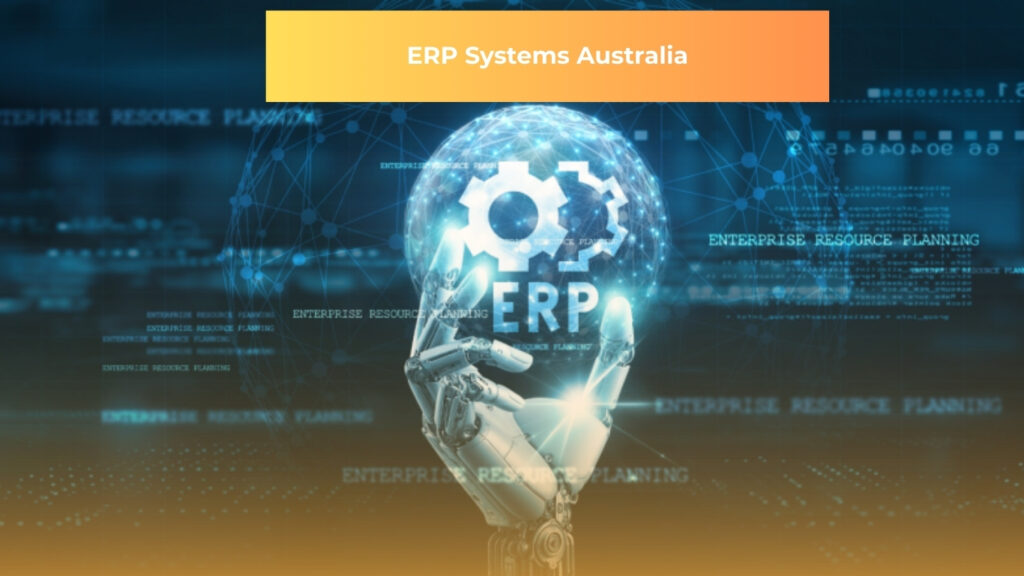ERP systems Australia have become crucial for IT leaders aiming for digital transformation in a global landscape marked by talent shortages and the imperative for cost-effective software development.
Did you know over 70% of enterprises now leverage ERP systems to manage operations, boost efficiency, and drive scalable growth?
This guide decodes the landscape of ERP systems Australia, explores what makes the top solutions stand out, and spotlights how modern B2B organizations are using scalable IT solutions and AI-driven IT services to maximize efficiency.
What Are ERP Systems Australia?

ERP systems Australia (Enterprise Resource Planning) are all-in-one software platforms that integrate vital business processes—finance, supply chain, sales, HR, and more—into a single, unified system. Whether cloud-based or on-premise, ERP systems help organizations manage operations, streamline workflows, and provide real-time data for smart decision-making.
Key features of popular ERP systems Australia include:
- Multi-department integration (finance, HR, inventory, sales)
- Local compliance (GST, payroll, Australian tax rules)
- Scalability, supporting startups to large enterprises
- Real-time analytics and reporting
How ERP Systems Australia Work: A Modern Approach
Modern ERP systems Australia leverage cloud technology and intelligent automation to deliver flexibility and scalability for every business type. Here’s how the process typically works:
- Needs Analysis: Assess business requirements, compliance needs, and desired outcomes.
- Solution Design: Customize workflows, integration points, and user roles.
- Implementation: Deploy modules across departments (often in phases for minimal disruption).
- Team Onboarding: Train users with intuitive dashboards and automated processes.
- Ongoing Optimization: Use real-time data and AI-driven insights for continuous improvement.
Dedicated IT teams and IT team augmentation are often involved during onboarding and ongoing optimization, especially for businesses scaling quickly or needing specialized expertise.
Top ERP Systems in Australia: 2025’s Leaders
Australian businesses are spoiled for choice, but only a few platforms consistently rank among the top ERP systems in Australia:
| ERP System | Key Strengths | Best For | AI Capabilities |
| SAP S/4HANA | Scalability, Vertical Depth | Large Enterprises | Advanced analytics, AI copilot |
| Microsoft Dynamics 365 | Local compliance, Flexibility | Growing SMEs, Finance, Retail | Machine learning, sales intelligence |
| Oracle Fusion Cloud ERP | Global reach, Security | Multi-region organizations | Automations, forecasting |
| Pronto Xi | Australian compliance | Domestic manufacturers, Retail | Operational analytics |
| Epicor Kinetic | Customization, Industry focus | Discrete manufacturing | Predictive maintenance, process AI |
| Acumatica Cloud ERP | Affordability, Accessibility | SMEs looking for scalability | Real-time AI dashboards |
Popular ERP systems Australia are increasingly shifting toward cloud and AI-driven platforms:
- Cloud ERP: Offers on-demand scalability, lower costs, remote access.
- Hybrid ERP: Combines cloud and on-premise modules for flexibility.
- AI-Driven ERP: Enhances automation, predictions, and user experience.
Key Benefits: Scalable & Cost-Effective IT Solutions
Why choose an ERP system? Leading solutions deliver clear advantages for any organization aiming for cost-effective software development and long-term scalability:
Benefits of ERP Systems Australia:
- Unified Data & Increased Visibility: Eliminate silos for all business functions.
- Scalability: Easily add modules as the business grows—no need for a complete overhaul.
- Cost Efficiency: Cut operational costs by automating repetitive tasks and optimizing resource allocation. Some businesses save up to 30% on IT spend with smart ERP deployments.
- Enhanced Decision-Making: Real-time analytics drive quicker, smarter choices.
- Compliance & Security: Built-in modules for Australian tax, payroll, and legal requirements.
- Remote Accessibility: Especially vital for Australia’s dispersed industries (mining, agriculture, services).
- AI-Enhanced Productivity: Automation relieves staff from low-value tasks—freeing them for innovation.
Challenges Facing ERP Systems Australia

No system is perfect. The most popular ERP systems Australia face recurring challenges—especially with integration and compliance:
- Complex Implementations: Integration with legacy systems or third-party apps can delay projects.
- Cost Overruns: Customization and ongoing maintenance sometimes require substantial investment if not managed.
- Change Management: Resistance often comes from users adjusting to new workflows or data processes.
- Compliance Risks: Failure to configure local rules (tax, payroll) can risk fines.
- Data Security: Especially for cloud-based solutions, ensuring data privacy is critical.
- Adaptability: Poor scalability or lack of flexibility leads to inefficiency or unnecessary costs.
Case Studies: Digital Transformation in Action
Case Study 1: Crossworks – Unified Project & Workforce Management
Challenge: Crossworks, a growing consultancy, suffered from disjointed project tracking and manual timesheets.
Solution: Implementing an ERP system unified timesheets, project management, and HR workflows. The result?
- Streamlined onboarding and task management
- Reduced manual tasks and errors
- Scalable processes supporting rapid business growth
Case Study 2: Woolworths Australia – Learning from ERP Implementation
Challenge: Woolworths’ $200M migration from a legacy ERP to SAP led to supplier payment issues and reporting disruptions.
Lesson: After initial challenges, Woolworths prioritized fixing IT issues and successfully implemented SAP Success Factors for HR—demonstrating that iterative problem-solving and expert partners can salvage complex projects.
The Rise of AI-Driven IT Services in ERP

Smart, AI-driven IT services are changing the ERP landscape in Australia and globally.
Key trends for 2025:
- AI-Powered Automation: 64% of CFOs cite AI/ML as game-changers for automation and predictive insights.
- Predictive Analytics: Anticipates sales trends, staffing needs, and supply chain disruptions.
- AI Copilots & Chatbots: Make ERP data accessible through natural language queries.
- Process Optimization: AI continuously tunes HR, finance, supply chain modules for peak efficiency.
- Scalable IT Solutions: AI allows for rapid scaling to new markets, product lines, or seasonal shifts.
When to Upgrade: Scenarios for ERP Adoption
Wondering if it’s time to explore ERP systems Australia? Ideal scenarios include:
- Rapid Scaling Needs: Growing SMEs needing scalable IT solutions.
- Manual Processes: High error rates, duplicated data, or Excel chaos.
- Compliance: New or changing tax, payroll, or industry regulations.
- Multi-Site or Remote Teams: Need for centralized, real-time data access.
- Industry-Specific Demands: Manufacturing, healthcare, education, and finance require tailored integrations.
When choosing among the top ERP systems in Australia, look for proven scalability, local compliance, and robust support for industry specifics.
HBLAB – Your Trusted Partner for ERP Systems in Australia

HBLAB delivers flexible, scalable ERP and IT solutions tailored to Australia’s dynamic business environment.
- 630+ skilled professionals with strong English proficiency, and 30% at the senior level (5+ years of experience)
- CMMI Level 3 certification, ensuring strict process excellence exceeding typical industry standards
- Cost efficiency – 30% lower than local developer rates, without sacrificing quality
- Flexible engagement: offshore, onsite, and dedicated teams covering diverse business needs
- AI expertise since 2017, including partnerships with leaders like VNU’s Institute for AI
- Comprehensive security & IP protection for peace of mind in sensitive projects
From fast-growth startups to large enterprises, HBLAB consistently delivers results through seamless integration and expert support.
Contact us for scalable IT solutions
Conclusion
Adopting ERP systems Australia is a decisive move for B2B organizations seeking efficiency, scalability, and future-proof growth. Leading platforms combine local compliance, automation, and AI to streamline operations across departments.
Whether your goals involve boosting profitability, improving compliance, or future-proofing your IT stack, the right ERP platform—supported by a top partner like HBLAB—delivers measurable results.
FAQ
1. What are ERP systems in Australia?
ERP systems in Australia are software platforms integrating key business operations—finance, HR, supply chain—into a unified solution optimized for local compliance and scalability.
2. What are the top ERP systems in Australia for 2025?
SAP S/4HANA, Microsoft Dynamics 365, Oracle Fusion Cloud ERP, Pronto Xi, Epicor Kinetic, and Acumatica Cloud ERP are leading choices, each offering different strengths for various business needs.
3. Why are cloud ERP systems popular in Australia?
Cloud ERP systems offer flexibility, lower upfront costs, remote access, and easy scalability—crucial for the geographically dispersed, fast-growing Australian business landscape.
4. What are the main benefits of ERP systems Australia?
They unify data, drive efficiency, ensure compliance, and provide real-time analytics—resulting in up to 30% IT cost savings for some organizations.
5. What risks or challenges come with ERP systems Australia?
Challenges include integration complexity, user adoption, potential cost overruns, and ensuring data security—especially in cloud environments.
6. Can ERP systems support AI-driven IT services?
Yes, leading solutions now feature AI-powered automation, analytics, and predictive tools—delivering new levels of efficiency and business intelligence.
7. How much do ERP systems cost in Australia?
Costs vary based on size, scope, and features—ranging from AUD 50,000 for basic systems to over AUD 500,000 for complex implementations.
8. When is the right time to upgrade to an ERP system?
Upgrade when facing business growth, inefficiencies from manual processes, compliance changes, or a need for unified remote access.
9. What should I look for in an ERP implementation partner?
Look for global experience, scalable support, compliance expertise, and strong references. HBLAB offers all these to help businesses succeed.
10. How do ERP systems drive scalable IT solutions?
They provide a framework for flexible expansion, allowing businesses to add new users, departments, or markets without costly systems overhauls.
Read More:
– Agentic AI vs Generative AI: The 2026 Breakthrough Businesses Can’t Ignore
– Salesforce Agency Australia: Transforming Customer Success Through Intelligent CRM Automation
– Cloud Solutions for Businesses: 2025 Proven Implementation Guide

